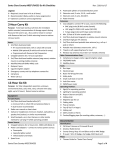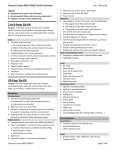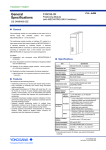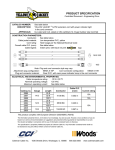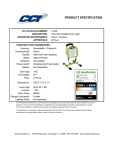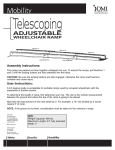Download improving operational efficiency with distributed
Transcript
IMPROVING OPERATIONAL EFFICIENCY WITH DISTRIBUTED MOTION NETWORKS: FINDING AND ELIMINATING THE WEAK LINK Abstract: As manufacturers face increasing pressure to reduce the costs of manufacturing, many are turning to the concepts of Just-In-Time manufacturing (JIT), also known as lean manufacturing. While lean manufacturing can improve the bottom line by reducing inventory costs, an increased stress is placed on the manufacturing process and associated equipment to achieve maximum uptime. Unexpected machine breakdowns or damage can have a significant and negative effect on the supply chain and customer service levels. This paper describes a machine control topology that can improve the speed of unexpected repairs by automatically configuring replacement servo amplifiers. Original Equipment Manufacturers (OEMs) and End Users can both realize resource optimization benefits from the reduced commissioning times achievable with a digital, distributed motion network. Copyright © 2008 Yaskawa Electric America • 2121 Norman Drive S. • Waukegan, IL. 60085 • 800-927-5292 (YASKAWA) • www.yaskawa.com Improving Operational Efficiency with Distributed Motion Networks A Scenario: Bob, production manager at Widgets, Inc., is calmly assembling some reports when a technician bursts through his door and blurts out “Hey Bob, someone just ran a forklift into Line A’s control cabinet and took out some servo amps. We’re down.” Bob’s face pales as he reaches for the antacid tablets… No production manager wants to hear those words. But it’s inevitable that every once in awhile, unfortunate and unexpected events will occur. One way to mitigate the risk of downtime occurrences is to build up additional safety stock. However, many manufacturers are under pressure to reduce manufacturing costs, and high inventory levels are a major use of operating capital. To be more competitive and increase efficiency, these companies generally realign their production processes to a Just-In-Time (JIT), or lean manufacturing structure. The end result improves bottom line performance by freeing cash otherwise tied up in inventory. However, the financial benefits of lean manufacturing are somewhat offset by the increased negative consequences of downtime occurrences. With reduced levels of safety stock, a disruption in a critical upstream process can create a ripple effect throughout the entire supply chain. The abilities to run consistently and repair quickly in the case of breakdown are critical needs in a lean manufacturing environment. At Widgets, the stricken production line featured digital servo amplifiers connected to an analog controller. From a technology perspective, this arrangement provides fairly good machine performance. The benefits of digital amplifiers over analog amplifiers are numerous and well-documented. However, digital servo amplifiers require setting internal parameters, usually through a communications port and an accompanying software environment. Failing to properly document the amplifier settings and train maintenance personnel on replacement procedures can lead to extended downtime if an amplifier should become damaged. Copyright © 2008 Yaskawa Electric America • 2121 Norman Drive S. • Waukegan, IL. 60085 • 800-927-5292 (YASKAWA) • www.yaskawa.com 2 Improving Operational Efficiency with Distributed Motion Networks The Problem: Our production manager, Bob, realized that the list of steps required to replace one of his amplifiers was rather lengthy and could result in extended downtime, particularly if he could not locate one or more of the required components. 1 2 3 4 5 6 7 8 9 10 11 12 13 14 Non-Networked Digital Servo Axis Replace amplifier Find user manual Find machine drawings with switch setting info Set all dip switches Find computer Find communication cable Find servo communication software Make sure software is loaded on computer Connect cable and establish communications Locate axis configuration file Transfer file to servo axis Disconnect and return computer to storage Replace the documentation so others can find it again Power up system Figure 1. Steps needed to replace a standard digital amplifier. Computer-based communication hardware, software, and operating-system technology can change several times during an industrial control’s life expectancy. As a result, servo equipment and configuration software may become dependent on obsolete technology. For example, several issues related to digital servo configuration have surfaced because of Microsoft’s operating system migration from DOS to Windows to Windows XP Service Pack 2 to Vista, and the disappearance of the hardware RS-232 serial communication port in favor of USB and Ethernet ports. Ideally, a highly maintainable system would be immune to technological changes in computer hardware or software, and would be free from reliance on highly trained personnel and specialized equipment for replacement. For the ultimate in maintainability, the machine controller would automatically detect that a hardware component had been swapped out and initiate an automatic configuration procedure so that the new hardware would match the old hardware. Such a system is possible with a digital motion network. The Solution: A machine controller using a distributed network topology directly supports the uptime and performance needs of a lean manufacturing production process. Figure 2 depicts a distributed control system using the MECHATROLINK high speed motion network to link axis and I/O nodes to the controller. The network supports several types of servo motion as well as variable frequency drives (VFDs). If necessary, multiple controllers can be linked by an inter-controller process network. Production data and/or process setpoints can be transferred to and from an upper level MES/ERP/SCADA network via an Ethernet connection. Copyright © 2008 Yaskawa Electric America • 2121 Norman Drive S. • Waukegan, IL. 60085 • 800-927-5292 (YASKAWA) • www.yaskawa.com 3 Improving Operational Efficiency with Distributed Motion Networks Figure 2. Yaskawa MP Series Mechatronics Machine Controller connects to servomotor axes, variable frequency drives and I/O nodes through a single MECHATROLINK digital motion network. The distributed network simplifies connections between the controller and the motion axes. The typical multi-conductor cables for command and feedback signals are completely eliminated and replaced by a single communication cable featuring locking, industrialized USB connectors. This not only saves installation time, but also increases the reliability of the system through better noise immunity and a drastically reduced number of potential failure points. The MECHATROLINK network also allows the controller to set amplifier parameters across the connection. This increases the flexibility and maintainability of the system. When coupled with a special programming instruction, replacement amplifiers can be automatically recognized and configured without the need for further operator intervention, saving a tremendous amount of time and lost production expense. Copyright © 2008 Yaskawa Electric America • 2121 Norman Drive S. • Waukegan, IL. 60085 • 800-927-5292 (YASKAWA) • www.yaskawa.com 4 Improving Operational Efficiency with Distributed Motion Networks How servo amplifier auto-configuration is implemented: Amplifier replacement can be automatically detected via the control program. By setting and monitoring a certain parameter in the amplifier, the controller can detect if an axis has been changed. The controller can then initiate the re-configuration process for that amplifier over the network in either an automatic or semi-automatic way. The only setting required by the maintenance technician is to properly set the amplifier’s address on the front panel rotary dip switch. Once all of the parameters are configured, the logic power on the amplifier will typically need to be cycled once prior to operation. This also can be done automatically provided the system is designed for that capability. Figure 3 shows a page from the amplifier configuration tab within the controller memory. The Servopack tab contains a complete listing of all the axis parameter settings. Figure 3. The Servopack tab within the controller memory contains a complete listing of amplifier parameter settings. Copyright © 2008 Yaskawa Electric America • 2121 Norman Drive S. • Waukegan, IL. 60085 • 800-927-5292 (YASKAWA) • www.yaskawa.com 5 Improving Operational Efficiency with Distributed Motion Networks Configuring an amplifier from within the control program is extremely simple. When executed, the MECHATROLINK Servo Write (MLINK-SVW) instruction, as shown in Figure 4, will automatically transfer all settings from the Servopack configuration tab down to the amplifier across the network. The program need only specify which network (circuit number) and which axis (station number) to configure. Figure 4. MECHATROLINK Servo Write instruction The benefits of auto-configuration: Implementation of a distributed control topology that supports servo amplifier auto-configuration benefits both OEMs and End Users. In a lean manufacturing environment, uptime is critical. A digital motion network like MECHATROLINK can improve the reliability and maintainability of the control system. Here are some other benefits to this control strategy: • Reduced installation and commissioning time • Increased reliability and productivity • Reduced training costs • Improved ease of maintainability • Reduced total cost of ownership • Improved operational and supply chain efficiency • Higher profitability The Scenario revisited: Widgets’ production line now features a machine controller with a MECHATROLINK distributed motion control network. Upon hearing of the forklift episode, Bob knows exactly what to do. “No problem Max. Just grab the spare amplifier, swap it out and turn the power back on.” Bob leaves the antacid tablets in the drawer because he knows that with the MECHATROLINK motion network, the replacement procedure has been reduced to only a few quick steps that anybody can accomplish. Networked Digital Servo Axis 1 Replace amplifier 2 Set address on rotary dial 3 Power up system Figure 5. Servo amplifier replacement procedure with a MECHATROLINK motion network. Copyright © 2008 Yaskawa Electric America • 2121 Norman Drive S. • Waukegan, IL. 60085 • 800-927-5292 (YASKAWA) • www.yaskawa.com 6 Improving Operational Efficiency with Distributed Motion Networks About MECHATROLINK: Yaskawa Electric Corporation is a member of the MECHATROLINK Members Association, currently comprised of over 237 industrial companies. Combined, these companies have now shipped over a half million nodes of distributed network product, and the number of new products continues to grow. The high growth rate can be attributed to the fact that MECHATROLINK is a truly open global standard. Unlike other proprietary or “pseudo-open” networks on the market today, MECHATROLINK specifications are rigorously enforced through global conformance testing that does not allow manufacturers to customize the implementation to the point of exclusivity. Yaskawa uses MECHATROLINK in its MP Series Mechatronics Machine Controllers as its preferred network option due to the network’s combination of high-speed performance and cost effectiveness. It is a smart choice because it is easy to install, provides easier and more flexible system configuration, has reasonable node costs, reduces overall cost of ownership and allows for high-speed and high performance control. Products with MECHATROLINK interfaces include servo controllers and amplifiers, variable frequency drives (VFDs), vision systems, temperature controllers, and input/output nodes. Only a single network communication line is needed to connect up to 16 motion axes plus 5 additional I/O slave nodes (21 maximum nodes), greatly reducing the cost and labor associated with wiring. The high-speed, realtime network provides simple, fast network control using a single, shielded twisted pair interface cable. Industrialized USB connectors provide simple and robust cable termination. Additional MECHATROLINK features and benefits include: • Communication cycle times as low as 0.5 msec for up to 4 servo axes and 2 msec maximum for up to 256 axes • Manchester-encoded-timing implementation to ensure deterministic and synchronized axis control over multiple networks • Multi-vendor selection of I/O modules allows flexible machine configuration • Simple wiring reduces assembly time and saves labor • All-digital network eliminates digital to analog conversions and simplifies system setup and maintenance • Absolute encoder support Summary: Lean manufacturing requires highly serviceable and reliable equipment. Yaskawa addresses this need from both a quality standpoint and a control system topology perspective. Yaskawa’s qualitydriven ISO 9001:2000 approach ensures the highest reliability of any servo system manufactured today, minimizing downtime occurrences. Distributed digital motion networks such as MECHATROLINK help improve supply chain and operational efficiency by improving performance reliability while simultaneously reducing installation and commissioning time. In the event that something catastrophic should happen to an amplifier, downtime can be minimized through an auto-configuration technique that can automatically recognize when an amplifier has been replaced, minimizing the amount of specialized knowledge required of maintenance personnel. Copyright © 2008 Yaskawa Electric America • 2121 Norman Drive S. • Waukegan, IL. 60085 • 800-927-5292 (YASKAWA) • www.yaskawa.com 7











